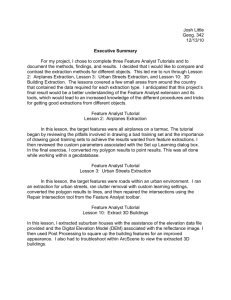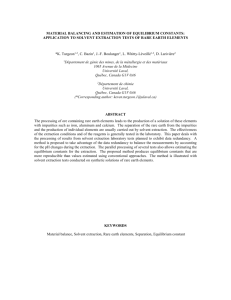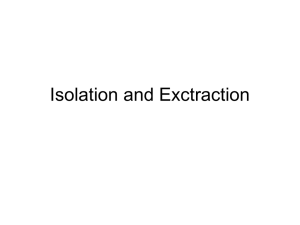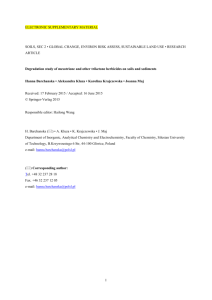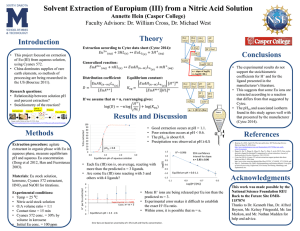Electronic Supplementary Material
advertisement
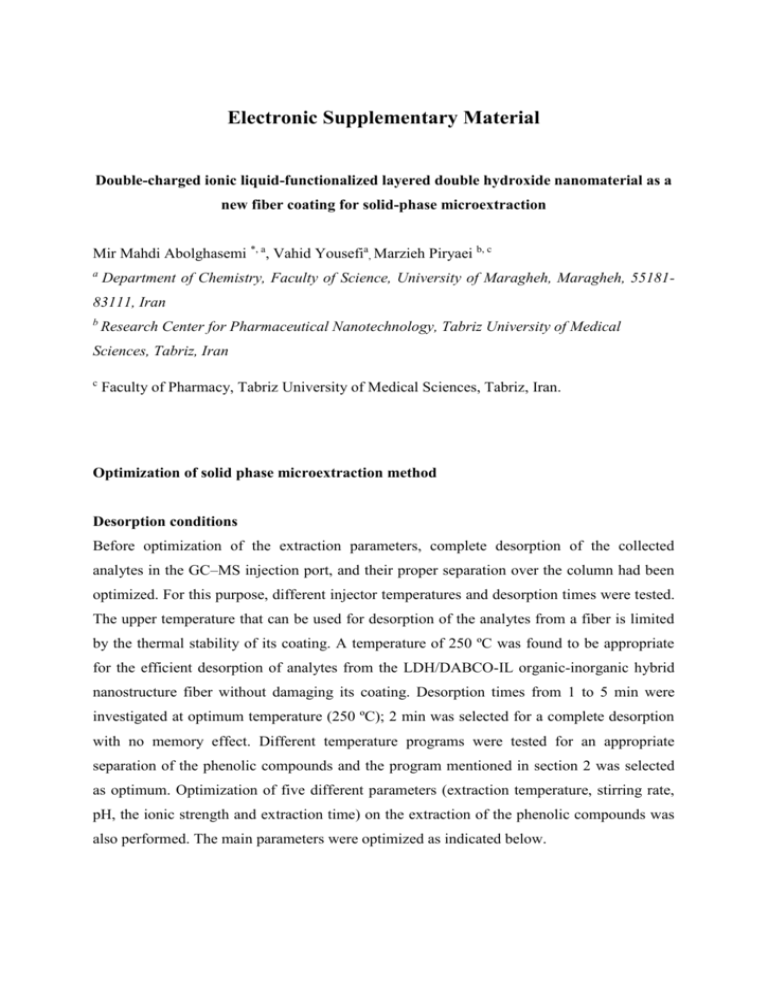
Electronic Supplementary Material Double-charged ionic liquid-functionalized layered double hydroxide nanomaterial as a new fiber coating for solid-phase microextraction Mir Mahdi Abolghasemi *, a, Vahid Yousefia, Marzieh Piryaei b, c a Department of Chemistry, Faculty of Science, University of Maragheh, Maragheh, 55181- 83111, Iran b Research Center for Pharmaceutical Nanotechnology, Tabriz University of Medical Sciences, Tabriz, Iran c Faculty of Pharmacy, Tabriz University of Medical Sciences, Tabriz, Iran. Optimization of solid phase microextraction method Desorption conditions Before optimization of the extraction parameters, complete desorption of the collected analytes in the GC–MS injection port, and their proper separation over the column had been optimized. For this purpose, different injector temperatures and desorption times were tested. The upper temperature that can be used for desorption of the analytes from a fiber is limited by the thermal stability of its coating. A temperature of 250 ºC was found to be appropriate for the efficient desorption of analytes from the LDH/DABCO-IL organic-inorganic hybrid nanostructure fiber without damaging its coating. Desorption times from 1 to 5 min were investigated at optimum temperature (250 ºC); 2 min was selected for a complete desorption with no memory effect. Different temperature programs were tested for an appropriate separation of the phenolic compounds and the program mentioned in section 2 was selected as optimum. Optimization of five different parameters (extraction temperature, stirring rate, pH, the ionic strength and extraction time) on the extraction of the phenolic compounds was also performed. The main parameters were optimized as indicated below. Temperature effect The first factor considered was the temperature effect. It is well known that the extraction temperature has a double impact on headspace SPME. Higher temperatures lead to higher vapor pressure of the analytes and hence their concentrations in headspace increase. On the other hand, partition coefficients of the analytes between fiber coating and headspace decrease with the temperature. The effect of temperature was studied in the range of 35–90 ºC by exposing SPME fiber in the headspace for 25 min. Fig. S1. presents the effect of solution temperature on the extraction ability, obtained by plotting phenolic compounds peak areas as a function of temperature. As can be seen, the extraction ability increases, with increasing temperature, up to 75 ºC, due to the increasing distribution constant of analytes between the aqueous phase and headspace. However, for most of the phenolic compounds a slight decrease in adsorption capacity was observed when temperature further increased up to 80 ºC. This is most probably due to decreased partition coefficients of analytes between headspace and fiber, because adsorption is generally an exothermic process. Fig.S1. Influence of the extraction temperature on the peak area of phenolic compounds. Conditions: phenolic compounds concentration: 10 ng mL−1, extraction time: 25 min, stirring rate: 700 rpm, NaCl: 10 %. Extraction time HS-SPME is an equilibrium-based technique, and there is a direct relationship between the amount extracted and the extraction time. Therefore, extraction time is a significant factor that affects the method efficiency. Extraction was performed from 10 to 50 min to determine the effect of extraction time on the method efficiency. The results shown in Fig. S2. illustrate the peak area versus extraction time profiles for the analytes. As expected, at the beginning the extraction efficiency increased with extraction time. All the studied analytes reached equilibrium after about 20 min.According to these results, a time of 25 min was chosen for subsequent experiments. Fig. S2. Effect of the extraction time on the peak area of phenolic compounds. Conditions: phenolic compounds concentration: 10 ng mL−1, extraction temperature: 80 °C, stirring rate: 700 rpm, NaCl: 10 %. The effect of pH Because of acid–base properties of the phenolic compounds and the importance of the effect of pH on their extraction, this effect was studied. The pH value of aqueous plays an essential role in the extraction process. Considering the sample solution pH is also one of the major factors that it progresses the transfer of analytes from the sample solution to the headspace. Therefore, after survey of the pH effect in the pH range 2–6, by adding the appropriate hydrochloric acid or sodium hydroxide solution to the aqueous phase. The maximum efficiency is obtained at pH 4. At low pH, the acid–base equilibrium for the phenols shifts significantly toward the neutral forms, which have high vapor pressure and greater affinities toward the fiber, and the extraction efficiencies are, therefore, increased. Effect ionic strength The salt has two effects on the extraction phenomenon: (1) it ties up H2O molecules in the aqueous phase (forming hydrated ions) so that less free water is available for solvation of analyte;and (2) it breaks down the hydrogen bond of the water structure, which makes it easier for analyte to extract into the headspace phase. This effect is called salting-out effect. The addition of salt often increased the ionic strength and thus increased the extraction efficiency due to the salting out effect. The effect of adding NaCl to aqueous sample was studied in the range of 0–30 % (w/v). The results indicated that the extraction efficiency increases with increasing concentration of NaCl, reaches a maximum in the presence of 10 % (w/v) NaCl and remains constant thereafter. The best results obtained for an aqueous sample containing 10 % (w/v) NaCl, which was three to eight times greater than that obtained for an aqueous sample with no added NaCl. Therefore, all further extractions were conducted with 10 % (w/v) NaCl added. Stirring rate Agitation of the sample improve mass transfer in the aqueous phase and induces the convection in the headspace, and consequently, the between the aqueous phase and headspace can be achieved more rapidly. In other words, sample stirring reduces the time required to reach the equilibrium by enhancing the diffusion of the analytes towards the fiber, especially for higher molecular mass analytes. Extraction efficiency of the studied compounds was measured from 5 mL of the model sample solutions containing 1 0% (w/v) NaCl and 25 min extraction times at various stirring speeds. The results revealed that extraction efficiency reaches a maximum and remains constant above 700 rpm. Table S1. The results obtained for the analysis of the spiked water samples (10 ng mL-1) by the proposed method, under the optimized conditions. Chichih river Polsangi bridge Compound 10.2(0.6)a 10.4(0.2) Phenol 10.4(0.4) 10.2(0.1) 4-Chlorophenol 10.4(0.7) 10.1(0.4) 2, 4-Dichlorophenol 10.3(0.2) 10.1(0.7) 2, 6-Dichlorophenol 10.5(0.3) 10.3(0.8) 2, 4, 6-Trichlorophenol 10.4(0.1) 10.7(0.6) 3- Aminophenol 10.6(0.3) 10.2(0.1) 4- Aminophenol 10.2(0.6) 10.7(0.2) 3-Nitrophenol 10.7(0.7) 10.6(0.4) 4- Nitrophenol a The figures within parentheses are standard deviations for three replicates.

